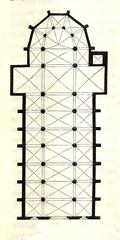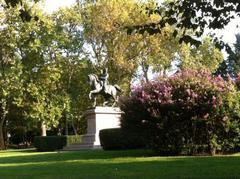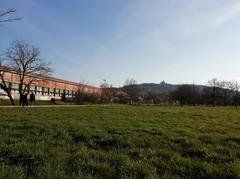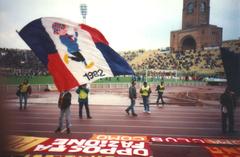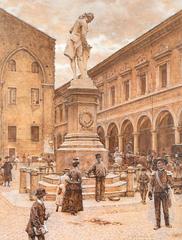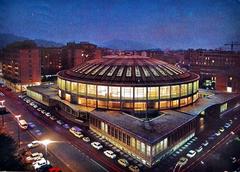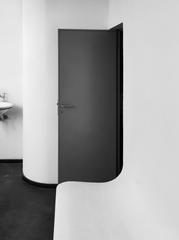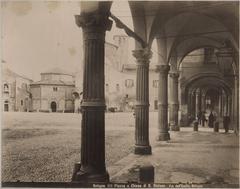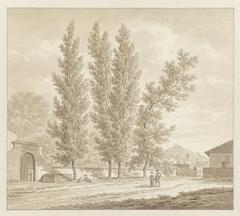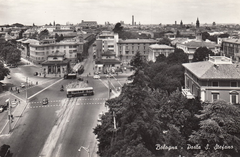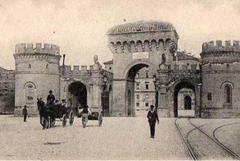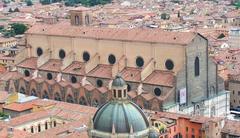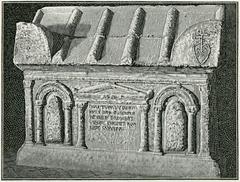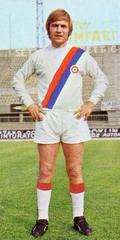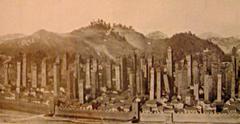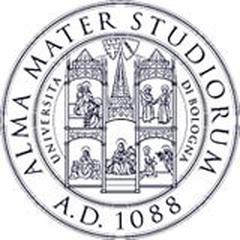
Comprehensive Guide to Visiting Mercato delle Erbe, Bologna, Italy
Date: 17/07/2024
Introduction
Nestled in the heart of Bologna, Italy, the Mercato delle Erbe is a historic market that has played a pivotal role in the city’s cultural, economic, and social life since its establishment in 1910. Designed by architect Arturo Carpi, this market replaced the older, more chaotic street markets, providing a more organized and hygienic environment for the sale of fresh produce and other goods. Over the years, Mercato delle Erbe has evolved into a vibrant, multi-functional space that reflects Bologna’s rich culinary heritage and architectural beauty. This comprehensive guide delves into the market’s history, cultural significance, visitor information, and more, offering a detailed overview for anyone planning to explore this iconic destination. Discover the charm and resilience of Mercato delle Erbe as it stands today, a testament to Bologna’s ability to preserve its cultural heritage while adapting to modern needs (Discover Mercato delle Erbe).
Table of Contents
- Introduction
- History of Mercato delle Erbe, Bologna
- Visiting Mercato delle Erbe
- Cultural Significance
- Architectural Highlights
- Visitor Tips
- Travel Tips and Nearby Attractions
- Conclusion
- FAQ
History of Mercato delle Erbe, Bologna
Origins and Early Development
The Mercato delle Erbe, located in the heart of Bologna, Italy, has a rich history that dates back to the early 20th century. The market was officially inaugurated in 1910, designed by the architect Arturo Carpi. It was built to replace the older, more chaotic street markets that had been scattered throughout the city. The aim was to create a more organized and hygienic environment for the sale of fresh produce and other goods.
The market’s construction was part of a broader urban renewal project in Bologna, which sought to modernize the city while preserving its historical charm. The building itself is a testament to early 20th-century architecture, featuring a blend of Art Nouveau and traditional Bolognese styles. The use of iron and glass in its construction was particularly innovative for the time, allowing for ample natural light and ventilation.
The Market During World War II
The Mercato delle Erbe played a crucial role during World War II. Despite the hardships and shortages caused by the war, the market remained a vital source of food and supplies for the local population. The building suffered damage during the bombings, but it was quickly repaired and continued to operate throughout the war years. This resilience made it a symbol of the city’s endurance and community spirit.
Post-War Reconstruction and Modernization
After the war, the Mercato delle Erbe underwent significant renovations. In the 1950s and 1960s, the market was modernized to meet the changing needs of the population. This included the installation of refrigeration units and improved sanitary facilities. The market’s layout was also reorganized to make it more accessible and user-friendly.
During this period, the market expanded its offerings to include not just fresh produce, but also meats, cheeses, and other specialty foods. This diversification helped to cement its status as a central hub for Bolognese culinary culture.
The Market in the Late 20th Century
By the late 20th century, the Mercato delle Erbe faced new challenges. The rise of supermarkets and changing shopping habits led to a decline in traditional market shopping. However, the market adapted by focusing on quality and local products, which helped to attract a new generation of customers interested in organic and artisanal foods.
In the 1990s, the market underwent another round of renovations. This included the restoration of its historical features, such as the original ironwork and glass panels, as well as the addition of modern amenities. These efforts were aimed at preserving the market’s historical character while ensuring it remained relevant in a changing economic landscape.
Recent Developments and Current Status
In recent years, the Mercato delle Erbe has experienced a renaissance. A major renovation project was completed in 2014, which transformed the market into a vibrant, multi-functional space. The project was led by the architectural firm Open Project and aimed to create a modern market that could serve as both a shopping destination and a social hub.
The renovation included the addition of new food stalls, restaurants, and communal dining areas. This has made the market a popular spot for both locals and tourists, who come to enjoy its lively atmosphere and diverse culinary offerings. The market now hosts a variety of events, from cooking classes to live music performances, further enhancing its role as a cultural and social center in Bologna.
Visiting Mercato delle Erbe
Opening Hours
- Monday to Friday: 8 AM - 8 PM
- Saturday: 8 AM - 6 PM
- Sunday: Closed
Ticket Prices
- Entry to the market is free, but prices for special events and guided tours vary.
Travel Tips
- The market is centrally located and easily accessible by public transport. Consider taking a bus or walking to avoid parking hassles.
Nearby Attractions
- Piazza Maggiore, Basilica di San Petronio, and the Two Towers are all within walking distance.
Accessibility
- The market is wheelchair accessible, with ramps and wide aisles for easy navigation.
Cultural Significance
The Mercato delle Erbe is more than just a place to buy food; it is a cultural institution in Bologna. The market reflects the city’s rich culinary heritage and its commitment to quality and tradition. Many of the vendors are small, family-run businesses that have been operating for generations, offering products that are deeply rooted in the local culture.
The market also plays a key role in the Slow Food movement, which originated in Italy. This movement advocates for the preservation of traditional and regional cuisine, and the Mercato delle Erbe is a prime example of this philosophy in action. Visitors can find a wide range of local specialties, from fresh pasta to cured meats, all produced using traditional methods.
Architectural Highlights
The Mercato delle Erbe is notable for its architectural features, which combine functionality with aesthetic appeal. The building’s iron and glass structure allows for natural light to flood the interior, creating a bright and welcoming environment. The market’s layout is designed to facilitate easy navigation, with wide aisles and clearly marked sections.
One of the most striking features of the market is its central atrium, which serves as a communal gathering space. This area is often used for events and performances, adding to the market’s vibrant atmosphere. The atrium is surrounded by a variety of food stalls and shops, offering everything from fresh produce to gourmet delicacies.
Visitor Tips
Best Time to Visit
- To avoid crowds, consider visiting early in the morning or later in the afternoon.
Navigating the Market
- The market is divided into different sections, each specializing in various types of goods. Take your time to explore each section to fully appreciate the variety of products available.
Language Tips
- While many vendors speak basic English, learning a few Italian phrases can enhance your experience. Simple phrases like “Quanto costa?” (How much does it cost?), “Posso assaggiare?” (Can I taste?), and “Grazie” (Thank you) can go a long way.
Payment Methods
- Most vendors at Mercato delle Erbe accept cash, and it is advisable to carry small denominations for easier transactions. Some stalls may accept credit or debit cards, but it is not guaranteed. There are ATMs nearby if you need to withdraw cash.
Sampling and Buying
- Many vendors offer free samples of their goods, so don’t hesitate to ask. When buying, it’s customary to let the vendor handle the produce rather than picking it up yourself.
Dining Options
- The market has several eateries and food stalls where you can enjoy traditional Bolognese dishes like tortellini, tagliatelle al ragù, and mortadella sandwiches. For a more relaxed dining experience, visit the market’s food court, which features a range of cuisines from Italian to international.
Sustainability Practices
- The market is committed to sustainability, and many vendors offer organic and locally sourced products. Bring your own reusable bags to reduce plastic waste.
Accessibility
- Mercato delle Erbe is wheelchair accessible, with ramps and wide aisles to accommodate visitors with mobility issues. There are also accessible restrooms available.
Photography
- Photography is generally allowed in Mercato delle Erbe, but it’s polite to ask vendors for permission before taking pictures of their stalls.
Special Events and Workshops
- Mercato delle Erbe often hosts special events, cooking classes, and workshops. These events provide a unique opportunity to learn more about Bolognese cuisine and culture. Check the market’s official website or social media pages for information on upcoming events.
Transportation
- The market is easily accessible by public transportation. Several bus lines stop near the market, and Bologna Centrale train station is just a 15-minute walk away. If you’re driving, there are parking garages nearby, but spaces can be limited, especially during peak hours.
Local Etiquette
- When visiting Mercato delle Erbe, it’s important to observe local customs and etiquette. Italians value politeness and good manners, so greet vendors with a friendly “Buongiorno” (Good morning) or “Buonasera” (Good evening). Be patient and respectful, especially during busy times.
Bringing Home Souvenirs
- Mercato delle Erbe is an excellent place to buy souvenirs. Consider purchasing local specialties like Parmigiano Reggiano cheese, balsamic vinegar, or artisanal pasta. These items make great gifts and are a delicious way to remember your visit to Bologna.
Travel Tips and Nearby Attractions
Safety Tips
- While Mercato delle Erbe is generally safe, it’s always wise to be cautious in crowded places. Keep an eye on your belongings and be aware of your surroundings. Pickpocketing can occur in busy markets, so use a secure bag and avoid carrying valuables.
Nearby Attractions
- After exploring the market, take some time to visit nearby attractions. The market is located in the historic center of Bologna, close to landmarks such as Piazza Maggiore, the Two Towers (Le Due Torri), and the Basilica di San Petronio. These sites are within walking distance and offer a deeper insight into the rich history and culture of Bologna.
Conclusion
Mercato delle Erbe is more than just a market; it is a multifaceted institution that embodies the essence of Bologna’s rich history, culture, and culinary traditions. From its early 20th-century origins to its recent renaissance, the market has continually adapted to meet the needs of the community while preserving its historical character. Today, it serves as a vibrant social hub where locals and tourists can immerse themselves in Bolognese life, savoring the authentic flavors and experiences that the market has to offer. Whether you’re a foodie, a history enthusiast, or simply looking to explore the local culture, a visit to Mercato delle Erbe is an unmissable experience. For more information and updates, follow us on social media or download our mobile app Audiala (Visitor Tips for Mercato delle Erbe).
FAQ
Q: What are the visiting hours for Mercato delle Erbe?
- The market is open from 8 AM to 8 PM Monday to Friday, and from 8 AM to 6 PM on Saturdays. It is closed on Sundays.
Q: Is there an entry fee for Mercato delle Erbe?
- No, entry to the market is free. However, some special events or workshops may have associated fees.
Q: Are there guided tours available?
- Yes, guided tours are available. It’s recommended to book in advance through the market’s official website.
Q: What types of products can I find at Mercato delle Erbe?
- The market offers a wide variety of local products, including fresh fruits and vegetables, meats, cheeses, and baked goods.
Q: Are there any nearby attractions to visit after the market?
- Yes, nearby attractions include Piazza Maggiore, Bologna’s Towers, and Basilica di San Petronio.
References
- Mercato delle Erbe - A Historical Gem in Bologna - Visiting Hours, Tickets, and More, 2024, Author (source)
- Discover Mercato delle Erbe - A Historic Market in Bologna - Visiting Hours, Tickets, and More, 2024, Author (source)
- Visitor Tips for Mercato delle Erbe, Bologna - Hours, Tickets, and More, 2024, Author (source)


